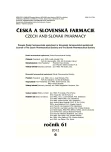Evaluation of content uniformity of tablets with a low content of the active ingredient with a narrow therapeutic index
Authors:
Jan Muselík; Aleš Franc
Authors‘ workplace:
Ústav technologie léků VFU, Brno
Published in:
Čes. slov. Farm., 2012; 61, 271-275
Category:
Original Articles
Overview
A short time ago there was a discussion about the use of NTI drugs such as warfarin. In the treatment by generic drugs some medical complications and deaths due to occult bleeding were retrospectively monitored. As a result of these observations, the generic substitutions with tablets containing warfarin were banned in the U.S. as there was a belief that generics have different pharmacokinetics. But a subsequent research found that different plasma levels are not due to generic drugs, but they are caused by different individual responses of the organism and especially by not uniform contents of warfarin in individual tablets. The different contents are caused by the method of direct compression where there is no granulation of the tablet blend before compressing. The method of direct compression, however, is very convenient in terms of time, technological feasibility and cost of cure. This report seeks to map the problems of direct compression in the production of tablets containing warfarin, concrete examples showing the relationships between selected parameters and the content uniformity of dosage form. Specifically, it is the influence of the density fillers and addition of the lubricant in various stages of mixing. On the basis of the application of statistical criteria according to the requirements of the FDA for the manufacture of tablets and with the use of the specific parameters of raw materials, the study has demonstrated that the technology of direct compression containing warfarin results not only in safe pharmacotherapy, but it also saves time, materials and cost of manufactured drugs.
Key words:
content uniformity • warfarin • GMP • validation • narrow therapeutic index
Received 19 September 2012 / Accepted 8 October 2012
Sources
1. European Commission: Annex 15 to the EU Guide to Good Manufacturing Practice - Qualification and Validation. Enterprise Directorate-General (EUDRALEX 2001).
2. E.U. European Medicines Agency, Sciences Medicines Health: Guideline on Process Validation. (EMA/CHMP/CVMP/QWP/ 70278/2012-Rev1 2012).
3. ČR. Státní ústav pro kontrolu léčiv: Pokyny pro správnou výrobní praxi - doplněk č. 15: Kvalifikace a validace (VYR 32 2003).
4. CFR – Code of Federal Regulations/Revised as of April 1, 2011. Current Good Manufacturing Practice for Finished Pharmaceutical (Title 21, Volume 4).
5. U.S. Department of Health and Human Services Food and Drug Administration: ANDAs: Blend Uniformity Analysis (CDER 1999).
6. U.S. Department of Health and Human Services Food and Drug Administration: Powder Blends and Finished Dosage Units — Stratified In-Process Dosage Unit Sampling and Assessment (CGMPs 2003).
7. Montgomery D. C. Introduction to Statistical Quality Control. 6th ed. New York: Wiley 2004; 734 s.
8. Pearn W. L., Shu M. H. Manufacturing capability control for multiple power-distribution switch processes based on modified C-pk MPPAC. Microelectron Reliab 2003; 43, 963–975.
9. Bergum J. S., Li H. Acceptance limits for the new ICH USP 29 content-uniformity test. Pharm. Tech. 2007; 31, 90–100.
10. The Federal Reporter: 386 F.3d 485 (2004). http://bulk. resource.org/courts.gov/c/F3/386/386.F3d.485.02-9346.02-9222.html (6. 8. 2012).
11. Henderson J. D., Esham R. H. Generic substitution: Issues for problematic drugs. South. Med. J. 2001; 94, 16–21.
12. Benson S. R., Vance-Bryan K. In favor of Coumadin over generic warfarin. Am. J. Health-Syst. Ph. 1998; 55, 727–729.
13. Carstensen J. T., Dali M. V. Blending validation and content uniformity of low-content, noncohesive powder blends. Drug Dev. Ind. Pharm. 1996; 22, 285–290.
14. Franc A., Rabišková M., Goněc R. Impregnation: a progressive method in the production of solid dosage forms with low content of poorly soluble drugs. Eur. J. Parent. Pharm. Sci. 2011; 16, 85–93.
15. Bolhuis G. K., Lerk F., Zijlstra H. T., de Boer A. H. Film formation by magnesium stearate during mixing and its effect on tableting. Pharmaceut. Weekbl. Sci. Ed. 1975; 10, 317–325.
16. Perrault M., Bertrand F., Chaouki J. An investigation of magnesium stearate mixing in a V-blender through gamma-ray detection. Powder. Technol. 2010; 200, 234–245.
17. Deveswaran R., Bharath S., Basavaraj B. V., Abraham S., Furtado S., Madhavan V. Concepts and techniques of pharmaceutical powder mixing process: A current update. Research J. Pharm. and Tech. 2009; 2, 245–249.
19. Siraj M. S., Radl S., Glasser B. J., Khinast J. G. Effect of blade angle and particle size on powder mixing performance in a rectangular box. Powder. Technol. 2011; 211, 100–113.
20. Chalabala M., Rabišková M., Pešák R., Masteiková R., Šolc J., Šrámek D. Základní operace a všeobecné postupy v technologii léků. In: Komárek P., Rabišková M. (eds). Technologie léků, 3. vyd. Praha: Galén 2006.
21. Moakher M., Shinbrot T., Muzzio F. J. Experimentally validated computations of flow, mixing and segregation of non-cohesive grains in 3D tumbling blenders. Powder. Technol. 2000; 109, 58–71.
Labels
Pharmacy Clinical pharmacologyArticle was published in
Czech and Slovak Pharmacy

2012 Issue 6
Most read in this issue
- Evaluation of content uniformity of tablets with a low content of the active ingredient with a narrow therapeutic index
- Analysis of pharmaceutical care in dispensing of over-the-counter orlistat
- Halloysite – interesting nanotubular carrier for drugs
- Comparison of sanguinarine production in suspension cultures of the Papaveraceae plants
